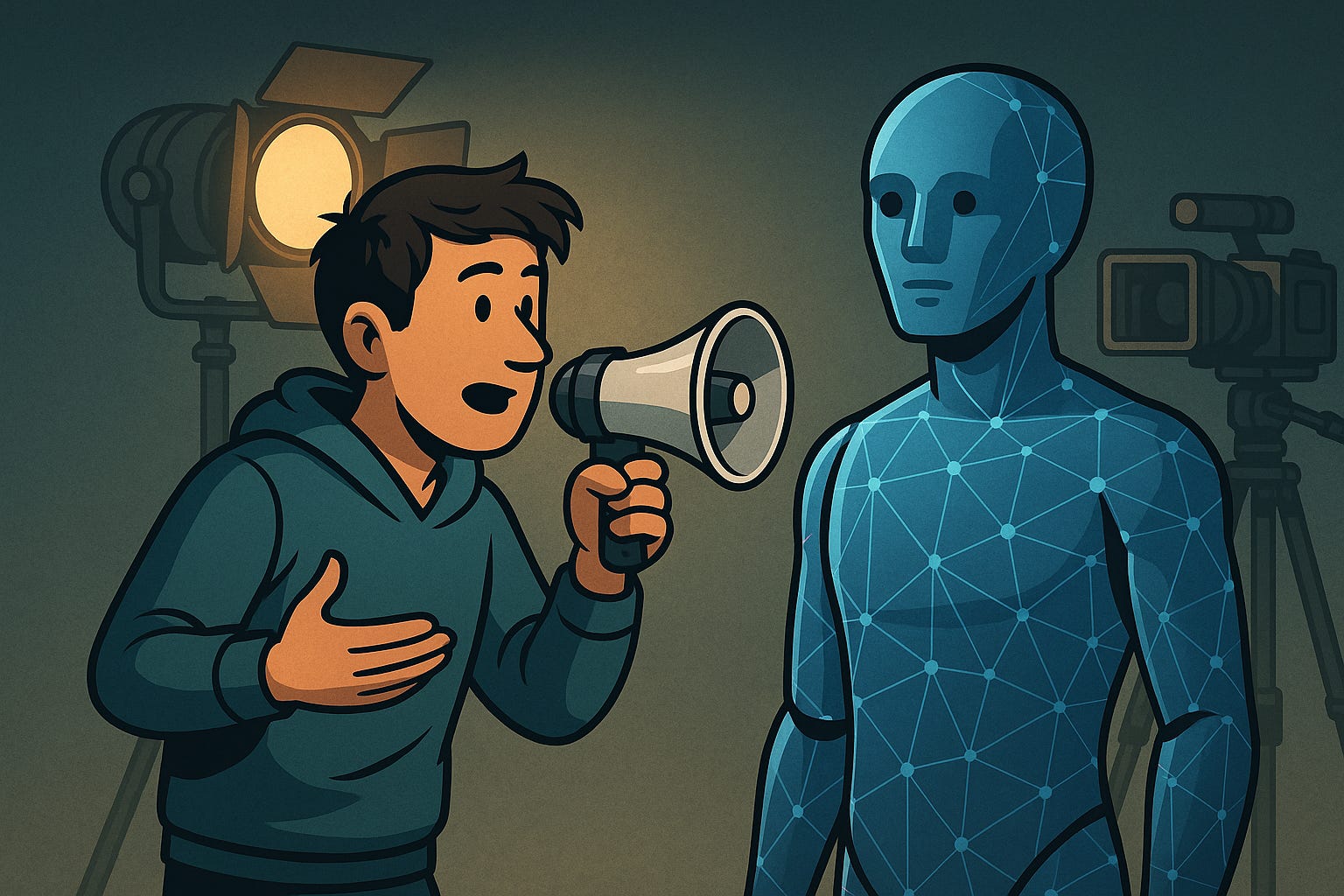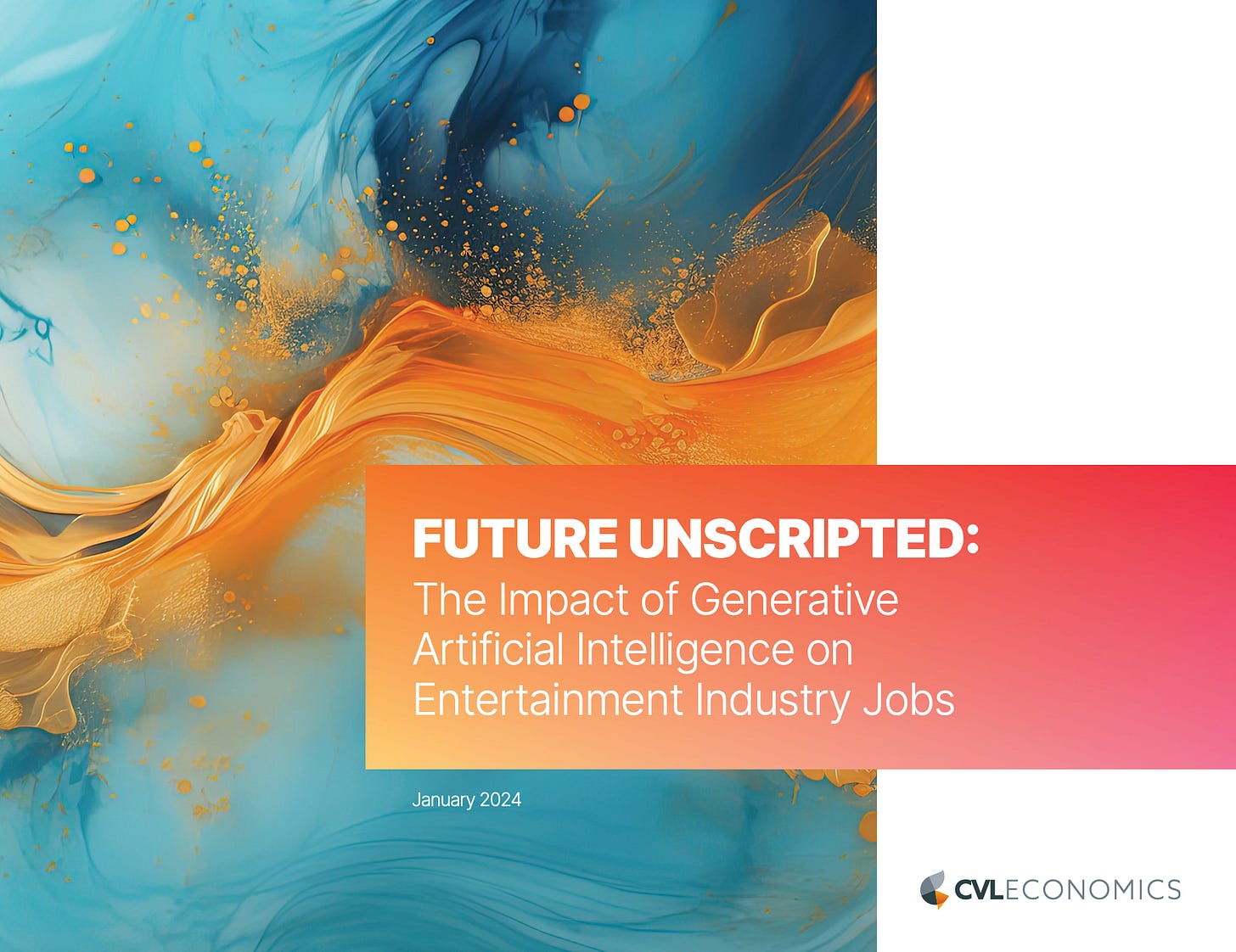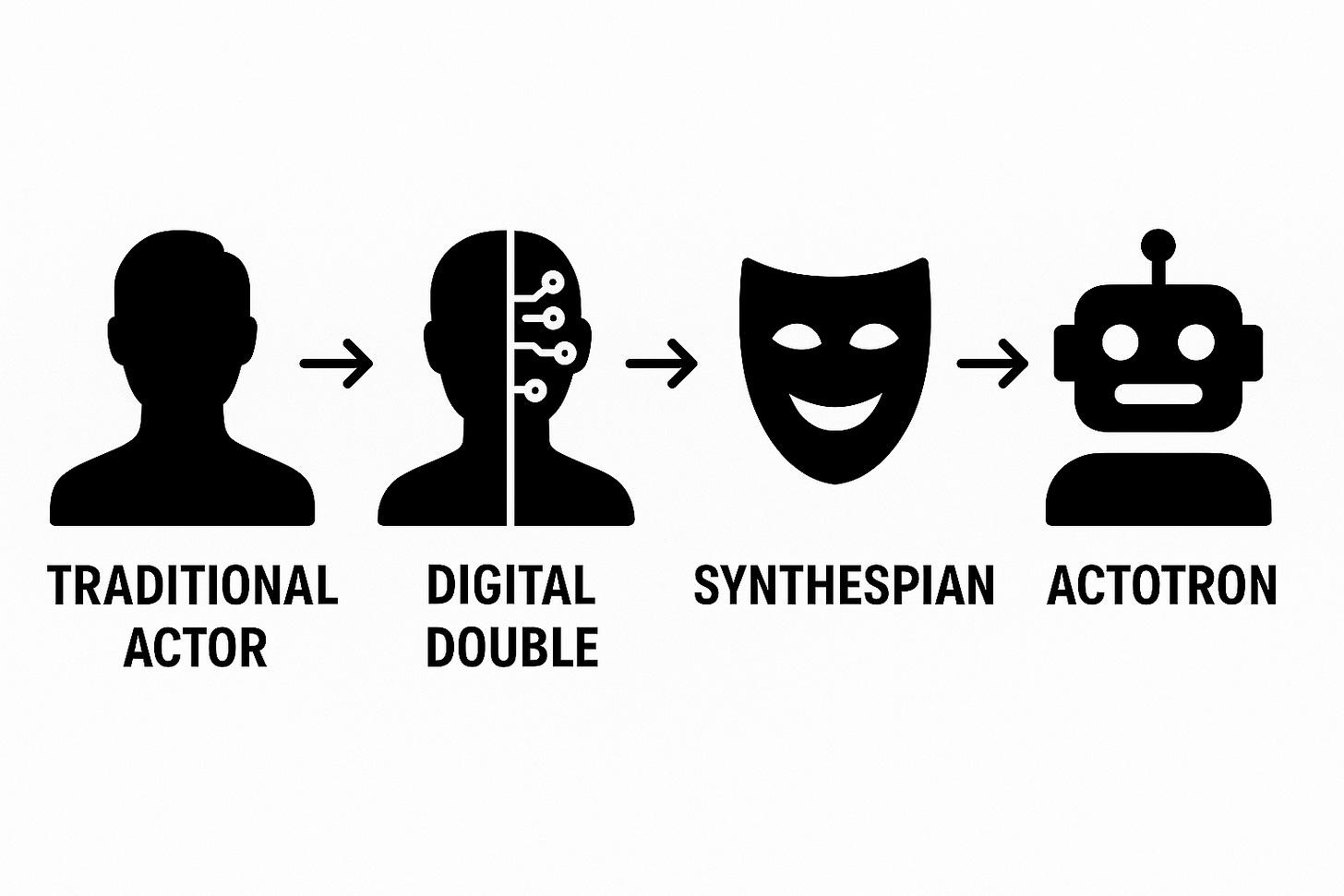Insider.Notes // Who Gets to Say “Cut”?
As AI rewrites the production playbook, we’re not just losing jobs—we’re losing decisions as automation flattens authorship. But in the wreckage of the old machine, a new creative grammar is forming.
Welcome to Insider Notes, the end-of-week intelligence drop from Creative Machinas. Each edition examines a single tension, threshold, or paradox shaping the intersection of AI, culture, and creative futures. It’s where signals turn into questions — and where thinking goes deeper than the surface.
TOP SIGNAL
Hollywood’s Fake Future Is Already in Theatres
Generative trailers. AI showrunners. Synthetic leads. The collapse isn’t coming—it’s already rendering.
This week, the clearest signal wasn’t in a think piece or studio memo. It was Echo Hunter, a fully AI-generated film that hit the market with a complete SAG-AFTRA-approved cast—and a production team that barely touched a camera. Paired with major exposés from New York Magazine and The Financial Times, a picture is emerging: generative AI is no longer hypeware—it’s Hollywood’s quiet scaffolding. Studios are testing AI-driven previsualisation, crowd simulation, voice cloning, and trailer generation not as experiments, but as replacements.
Runway’s CEO says the goal isn’t disruption—it’s a new creative grammar. But the signs are clear: pitch decks powered by Midjourney, trailers cut by Gen-2, and production timelines that favour synthetic over staffed. One exec called it “an arms race for plausible spectacle.” Another warned of a future where AI makes promises the final film can’t keep.
The industry hasn’t turned a corner. It’s building a new street. And no one’s sure who owns the pavement.
(Sources: Vulture, TechRadar, Financial Times, The Verge)
WHY IT MATTERS
Generative AI isn’t arriving at the edges of the entertainment industry; it’s settling at the centre. The rise of tools like Runway, Wonder Studio, and OpenAI’s video models isn’t just transforming workflows; they’re altering the assumptions underneath them. What we’re witnessing isn’t a disruption. It’s a strategic reconfiguration: faster pipelines, smaller crews, lower costs, and fewer humans in the loop.
But what begins as efficiency becomes erasure. AI is being adopted not to supplement labour, but to simplify it, to remove friction, headcount, and complexity. When studios greenlight films based on synthetic trailers or sell projects off concept art generated in Midjourney, the creative process becomes an exercise in plausibility, not originality. That’s not future shock. That’s present tense.
And this isn’t just about lost jobs. It’s about lost infrastructures of creativity: the assistant editor who became a director, the storyboard artist who became a showrunner, the animator who learned pacing by fixing bad scenes. AI doesn’t just compress the work—it compresses the ladder.
The deeper risk isn’t technological, it’s structural. As AI becomes a default toolset for prototyping, casting, editing, and visualising, we risk shifting from a creative industry to a synthetic one, where art is a deliverable, not a discovery. Even the language is shifting—“content” over “cinema,” “assets” over “actors,” “pipeline” over “process.”
The final irony? AI may open the door to a new generation of creators, bedroom auteurs, and independent visionaries, just as it closes it on those who once learned the craft through collaboration. That’s the cost of compression: a thinner, faster, lonelier future.
DEEP SIGNAL
Hollywood still appears to be a dream machine. But under the hood, it's eating itself alive—each amazing scene hiding a shrinking crew, a slashed budget, and a silent machine doing the work.
Laundered Spectacle: AI, Economics, and Hollywood’s Coming Collapse
The billion-dollar blockbuster wasn’t killed by bad scripts or superhero fatigue—it’s being slowly dismantled by economics, automation, and the quiet disappearance of people.
A System Sinking Under Its Own Weight
Hollywood isn’t just bloated. It’s collapsing under the gravitational pull of its own industrial complexity. In the age of billion-dollar tentpoles, visual effects arms races, and endless layers of creative middle-management, the system designed to deliver cinematic spectacle is now haemorrhaging under the cost of its own collaboration. This isn’t merely an industry problem—it’s a structural implosion in the making.
The production ecosystem, particularly in VFX, has become labyrinthine. Hundreds of subcontractors stretch across global pipelines. Even minor creative decisions are mediated by vast webs of approvals. This hyper-collaborative sprawl once enabled scale; now, it threatens it. This is a system breaking under its own weight, where the sheer volume of moving parts renders any mid-budget creative possibility extinct. You're either in the $300 million spectacle game or on the fringe with micro-indies. There is no in-between.
And AI? It’s not just a disruptor—it’s the pressure valve.
The trailer is no longer a preview. It's a simulation of a movie that may never exist—an illusion engineered to sell hype, not story.
The Laundering Layer: Generative AI’s Dirty Secret
In a landscape where union contracts and public perception still penalise open AI use, a quiet laundering system has emerged—even after the 2023 WGA contract update addressed AI transparency and labour protections, enforcement remains porous and difficult to trace1. AI doesn’t appear in the credits, but it’s everywhere in the pipeline. Studios are increasingly using AI-generated visuals as the basis for human-made recreations, allowing them to claim the final product is fully human-authored. This act of creative camouflage is the digital equivalent of laundering money—an AI-generated storyboard becomes a “reference,” which becomes a human-led render, effectively whitewashing its machine origins.
This laundering is well-documented. Artists are routinely instructed to “touch up” AI-generated mood boards or concepts so the final asset can be labelled human-made2. Concept artist Reid Southen described how producers now ask for “AI touch-ups” that scrub visible machine fingerprints (Shapiro, 2024). One studio executive admitted: “Storyboard artists are out of business… unless they become good at prompting”3.
The ethics here are murky, but the economics are crystalline. This laundering isn’t just visual. It’s strategic. Studios increasingly rely on AI to prototype scenes, animations, or beats until they’re “human enough” to pass as original—then bury the AI’s role in the credits, if it’s acknowledged at all.
Economics as the Ultimate Disruptor
If ideology doesn’t drive change, economics will. Studios now face a grim arithmetic: films costing $200 million must double or triple that at the box office just to break even. As Lionsgate’s Michael Burns put it, “We can’t make it for $100 million, but we’d make it for $50 million because of AI”4.
Studios are already pre-selling films off AI-generated trailers for movies that haven’t even been shot. In the same interview, Burns described generating scenes with AI from a script to attract investors—turning a $10 million project into something that looks like a $100 million blockbuster5.
In this calculus, generative AI isn’t about replacing human labour with machines. It’s about collapsing the number of humans involved in the first place. AI becomes the ultimate simplification mechanism—a blade slicing through a bureaucracy bloated by decades of industrialised storytelling.
From Spectacle to Simulation: The Blockbuster’s Slow Death
Generative AI is already performing VFX sleights of hand that were once the domain of high-end studios. Runway’s models contributed a 90-second fantasy sequence to Amazon’s House of David, a feat unthinkable at that budget using traditional methods6. Wonder Dynamics’ Wonder Studio enabled 134 creature shots for Superman & Lois in just six weeks by automating motion capture and CG compositing without traditional suits or rigs7.
And yet, this efficiency comes with an uncanny price. Much of what AI enables feels like simulation, not cinema. The trailer is no longer a preview. It's a simulation of a movie that may never exist—an illusion engineered to sell hype, not story. AI-generated trailers may soon promote visual promises that the finished film cannot fulfil, leading to mismatches between marketing and final content. It’s not about artistic cohesion anymore—it’s about economic plausibility. A $10M AI-assisted film needs to look like it cost $100M. The trailer isn’t a preview; it’s a mirage. In one recent example, AI was used to automatically scrub over 30 F-bombs from the film Fall (2022) using deepfake lip-sync tech, creating an alternate version suitable for wider distribution without any reshoots 8.
The Disappearance of the Junior Creative Class
This transition is not without casualties. Junior artists, animators, and VFX assistants—the apprenticeship backbone of Hollywood—are already being phased out. According to a 2024 CVL Economics study, 75% of Hollywood execs had already merged or eliminated roles due to AI adoption9.
Rotoscoping, animatic design, even voice dubbing are increasingly handled by generative systems 10. The traditional entry path into the industry—through junior creative roles—has effectively disappeared. That well-worn trail of mentorship and mastery has been paved over by prompt engineering and automated pipelines. The industry isn’t just automating jobs—it’s automating the ladder. What emerges in its place is unclear, but what’s vanishing is obvious.
One of the most startling data points came from a 2025 analysis, which reported over 200,000 job losses in the entertainment sector tied directly to AI adoption11. These aren’t future threats—they’re present casualties, unfolding in real time as generative systems scale.
The Return of the Bedroom Auteur
Ironically, what threatens to undo Hollywood may also revitalise it. Generative AI enables a return to garage-band filmmaking—except now the garage is a GPU cluster. Bedroom auteurs with access to cloud-based models can produce sequences once reserved for blockbuster budgets. What took 200 VFX artists might soon be achievable by two12.
This shift signals a return to story-first filmmaking, where creators can work with inexpensive tools like iPads rather than chasing massive financial returns. Proponents argue AI tools are merely the next iteration of the digital brush—enhancing rather than erasing human creativity. But that argument collapses when the economic pressure is to replace, not supplement. This is AI’s real promise—not industrial efficiency, but narrative autonomy.
And emerging research suggests the shift may go even deeper. Futurecasting research suggests that AI-driven virtual actors—capable of learning, adapting, and performing in real time—will fundamentally alter the creative dynamics of storytelling13. The Actotron doesn’t just reduce labour. It reframes the notion of performance itself, allowing creators to direct sophisticated virtual humans like real actors in digital environments. What happens when we no longer need actors at all? As AI actors begin to convincingly simulate complex emotions, the line between authenticity and simulation begins to dissolve, raising the unsettling possibility that audiences might respond more deeply to synthetic performances than to real ones. The cultural and emotional foundations of performance could shift entirely, challenging our very understanding of presence, persona, and the value of embodied experience.
Unlike traditional forecasting, which extrapolates from past data, futurecasting embraces a non-ergodic model—one in which historical precedent is no longer reliable. It anticipates radical change, not just acceleration. By using methodologies from Future Studies, such as the non-ergodic “possibility-space” approach, the research argues that Actotron technology will make production more fluid, accessible, and decentralised, particularly for creators outside the traditional studio system14. In this vision, generative AI isn’t just an industrial tool; it’s a narrative partner.
But that promise will be lost unless ownership, authorship, and transparency evolve in parallel. Without that, AI won’t democratise storytelling. It will privatise it.
So The Deep Signal Is …
The story of AI in Hollywood isn’t one of invention. It’s one of compression.
Compression of labour. Compression of risk. Compression of vision.
Hollywood has always been a system of layered excess. Generative AI doesn’t dismantle that system—it distills it. The laundromat metaphor isn’t just apt. It’s precise. AI outputs are filtered, scrubbed, repainted, and returned to the world with the illusion of human touch. But what’s really being laundered is authorship itself. These aren’t just visual tools—they’re hype machines. Designed to sell dreams upstream while automating labour downstream.
The deepest signal here? This isn’t the death of cinema. It’s the slow death of collaboration as we know it.
And in its place: an uneasy rebirth of a faster, lonelier, more agile visual machine. And for an industry collapsing under its own complexity, that new machine may be the only thing left that still fits.
THREE MOVES
Spot the Ghostwork
Fire up a recent blockbuster or trending show. Now squint a little. What parts feel strangely frictionless, overly clean, or oddly generic? Trailers, transitions, creature shots—where might the invisible machine be hiding? Ask yourself: if AI touched this, do you care?Run the Collapse Scenario
You’re making a short film in 2032. The script’s yours—but everything else can be AI: cast, camera, score, trailer. What do you still insist on doing yourself? What are you weirdly fine letting go? That gap? That’s your threshold for human storytelling.Watch the Mirage
Hit play on Echo Hunter below, an AI-made short from Arcana Labs. Let it wash over you, then pause. What felt “real”? What didn’t? If you hadn’t known it was AI-generated, would you have clocked it? And if you did know—did it matter?
FAST LINKS
Runway CEO on AI Video and Hollywood's Future (The Verge) [In-Depth]
Echo Hunter: A Fully AI-Generated Film with SAG-AFTRA Cast (TechRadar) [Case Study]
Could AI Make a Scorsese Movie? (Financial Times) [Expert Analysis]
Everyone Is Already Using AI (And Hiding It) (Vulture) [In-Depth]
Explores the creation of "Echo Hunter," a sci-fi short film produced entirely using AI tools, featuring performances from union actors (YouTube) [Behind-The-Scenes]
STUDIO WHISPER
Justin says:
When I first developed the Actotron concept (with my colleague Angelique), it felt like futurecasting, plausible, but still a few major leaps away. The Alex scenario, where a single creator directs entire films from a bedroom studio, was meant to stretch the imagination. But now? With the release of tools like VEO3 from Google, that distant horizon feels alarmingly close. What I thought was five or ten years out now looks like it’s just around the corner. The pace isn’t just fast—it’s erasing the space between foresight and fact.
SAG-AFTRA & WGA. (2023). Summary of the 2023 WGA MBA. Writers Guild of America. https://www.wgacontract2023.org/the-campaign/summary-of-the-2023-wga-mba
Shapiro, L. (2024, April). Everyone is already using AI (and hiding it). New York Magazine. https://www.vulture.com/article/generative-ai-hollywood-movies-tv.html
Ibid.
Ibid.
Ibid.
Ibid.
Ibid.
Porter, J. (2022, August 10). Fall movie removed 30+ F-bombs with deepfake tech. The Verge. https://www.theverge.com/2022/8/10/23299565/fall-2022-movie-fucks-gone-ai-technology-flawless-f-bomb
CVL Economics. (2024, January). Future unscripted: The impact of generative artificial intelligence on entertainment industry jobs. https://animationguild.org/wp-content/uploads/2024/01/Future-Unscripted-The-Impact-of-Generative-Artificial-Intelligence-on-Entertainment-Industry-Jobs-pages-1.pdf
Shapiro, Everyone is already using AI (and hiding it)
Mendoza, C. (2025, June). Hollywood replaces 200,000 workers with AI: Studios stay silent as jobs vanish. Medium. https://medium.com/@telumai/hollywood-replaces-200-000-workers-with-ai-studios-stay-silent-as-jobs-vanish-4bf1f1ee19ee
Ibid.
Matthews, J. R., & Nairn, A. (2024). The Actotron: Envisioning the future of virtual actors and digital storytelling. M/C Journal, 27(6). https://doi.org/10.5204/mcj.3118
Ibid.








